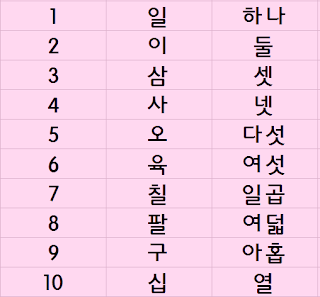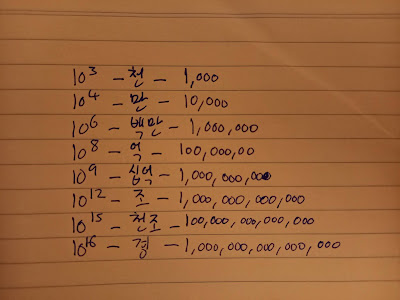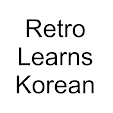This article is going to presume that you have at least the knowledge of the number systems, although as we all know knowledge is not acquisition. I will try to cover some strategies you can use to better help remember the numbers and also make it more natural to read them in Korean.
As anyone who has tried to learn another language will know it's very difficult to read a written arabic number without defaulting to saying it in your native language. I know many people who are extremely fluent in English and say they always count in their native language. However our aim should be to at least be comfortable with numbers so that we can tell people things like our age or our birth date.
I've found while learning Korean that numbers come up very often in various ways and it has become beneficial for my reading speed and understanding to be able to automatically know the number in Korean. For reference I will refer to 일, 이, 삼 as the Sino-Korean system and 하나, 둘, 셋 as the pure Korean system.
 |
| Left: Sino-Korean, Right: Pure Korean |
Understanding and recalling basic numbers
The first thing we want to really get down is knowing both the basic number systems and the order. For me the Sino-Korean system came much more naturally. I'm not entirely sure the reason for this but I think it's because they show up much more often. Getting input will gradually help you understand numbers better over time but we can use a few techniques to nail them down quicker.
As a general rule, if you want to make numbers more automatic you need to get the sound into your head. When I first started reading I would always use the 'read aloud' function so I could hear the number. Sometimes I would be wrong but gradually I needed to use it less and less. Generally you will know which number system you should use because the pure Korean system is always followed by a counter which you should be able to identify as it will follow the order of: noun number counter.
We can practice the order and remembering the numbers by playing a little game when we go out or go up stairs. A few months into learning, I read this tip and I think it really helped me remember them much better. Prior to using this method I really struggled with the order after 넷 and 사. We can start off by testing ourselves counting every step 1 to 10 repeatedly.
You will notice when you first try this and even for a few days you may have certain numbers that you get stuck on. for me it was 5-8 that would consistently trip me up. I tried many different ways of counting, I tried restarting every time I failed but this just made my 하나, 둘, 셋, 넷 even better. It really helped me to start counting in 2's so that once I got to 다섯, 여섯, I would repeat 다섯, 여섯 for a few steps then move on to 일곱, 여덟 and repeat them for a few steps.Once you can get from 1-10 in both you can try counting by 2's odd numbers then even numbers. This is to continually test your knowledge of the actual numbers and to make sure you haven't just memorised the pattern. You can also use this to practice numbers all the way up to 100 for pure Korean and infinitely for Sino-Korean.
Big numbers and money
Something that I've seen people say is that it's not worth knowing the pure Korean numbers past 30. The only thing I can say to this is 개뿔. I continuously and constantly see people using these numbers for ages and counting all the time. I noticed very early on after seeing them that, after 50 the numbers have a very obvious pattern to them. Hopefully you can notice the pattern to and use it to help you better remember them.
- 여섯 (6) - 예순 (60)
- 일곱 (7) - 일흔 (70)
- 여덟 (8) - 여든 (80)
- 아홉 (9) - 아흔 (90)
Money is important everywhere in the world and Korea is no exception. However the currency displays itself a little differently as in most currencies around the world general daily use money rarely goes above a couple hundred. Korean Won however notes lowest denomination is 1000 and large sums of money can go into the millions relatively easy. This makes it harder for foreigners in a third way beyond having 2 number systems you also have to know relatively large numbers to actually get by using money.
First thing is we should learn the denominations in which we can expect to deal with cash. Thankfully when dealing with cash, we can just give people a higher amount than we need to and they will give us the change. Sadly we still need to learn these numbers to have an understanding of what exactly people are talking about. Below we can see the current notes and coins in circulation.
 |
| Korean Won denominations |
Trying to deal with extremely large numbers and the way that numbers are divided in the oriental fashion can be quite confusing when you are trying to brute force it. We can use our knowledge of mathematics and science to help us better understand the divisions. It can be especially confusing that large numbers have no divide such as a comma or full stop as they would in the west. You can often see Koreans counting the zeroes in a long number, instead of being displayed as 10,000,000 they are written as 10000000.
Usually when written in book and sometimes on the news they will use the denominations such as 만, 억, 경 instead of listing really large numbers, as they are always unclear. When I first saw them I was thinking there must be a way to better remember them. I thought about my school days and how they reminded me so much of SI units like: kilo, mega, giga. By using standard form we can give ourselves a better way to deal with them.
 |
| Standard form to remember the divisions |
I've written the number as a visual guide but as you can see the main denominations are divided up into 10^4 rather than the western 10^3. Now I understand some people may not quite understand what is happening here but for those that do I hope it is helpful.
While I'm mentioning mathematics let me give you some common words that you will encounter:
- Addition (더하기) [+]
- Subtraction (빼기) [-]
- Multiplication (곱하기) [*/x]
- Division (나누기) [/ or ÷]
and the bonus:
- Fractions (분수) 1/3 read as 삼 분의 일
Conclusion
Really mastering numbers in a foreign language takes a lot of input and a fair amount of deliberate practice. Our aim with deliberate practice is to iron out the deep creases left by our native language on reading Arabic numerals.
Not to say that you can't get by simply just translating numbers in your head from your native language but if you want to feel more at one with the language, knowing numbers well will help you become more engrossed while reading and speaking.
If these tips were helpful or if you have any other questions about aspects of learning Korean, don't hesitate to contact me or leave a comment below. Thank you for your time and stay safe.
For related posts please check out these pages:
- Is Learning Hanja(한자)[漢字] as Korean Learners important?
- Talk To Me In Korean Book Review and Thoughts on the Curriculum
- The Role of Listening in Language Learning
- The Monolingual Transition and How to Approach it
- Realistically How Long Does it Take to Learn a Language?
- Watching Media and Using Subtitles to Learn a Language
- How to Spend as Much of Your Day as Possible Learning Korean
- How to Type in Korean and How to Practice Typing Faster
- Smartphone Apps For Learning Korean
- How to Use Ridibooks(Korean Ebook Store)
- Using Audio Description for Language Learning
- Talk to Me in Korean Advanced Idiomatic Expressions Reference List
- How to Learn Korean in 2021
- I read 61 Korean books in 2020
- Korean Dictionary Symbols Explained


No comments:
Post a Comment
Share your thoughts on this topic